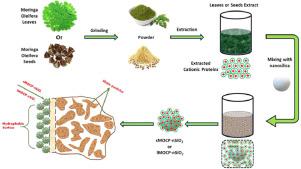Chemical Engineering and Processing: Process Intensification ( IF 4.3 ) Pub Date : 2021-08-14 , DOI: 10.1016/j.cep.2021.108589 Azeem Rana 1 , Tawfik A. Saleh 1 , Mohammed K. Arfaj 2

|
Wellbore stability in the presence of water-based mud (WBM) is a key challenge for the oil and gas industry. The present work reports the development of a cost-effective, efficient, and environment-friendly shale inhibitor by using Moringa Oleifera cationic protein-modified nanosilica (MOCP-nSiO2). The functionalized nSiO2 improved the swelling inhibition features of the shale materials as compared to unmodified nanosilica. The linear swelling, shale inhibition stability, dispersion recovery, and sedimentation tests were utilized to assess the inhibition features of modified WBM. The lMOCP-nSiO2 modified WBM (lMOCP-nSiO2-WBM) demonstrates the maximum shale dispersion recovery (90.1%) as compared to sMOCP-nSiO2-WBM (81.8%), nanosilica (78.7%), unmodified drilling mud (70.2%), KCl (48.6%), and water (25.1%). Improvement in rheological features of the sMOCP-nSiO2-WBM and lMOCP-nSiO2-WBM was observed. To confirm the adsorption of cationic protein on the surface of the clay and its inhibition process was inspected by several sorts of methods such as Fourier transforms infrared spectroscopy (FTIR) analysis, thermogravimetric analysis (TGA), X-ray diffraction (XRD) analysis, and scanning electron microscopy (SEM). The outcomes disclosed that sMOCP-nSiO2 and lMOCP-nSiO2 plug the nanopores and carries functional groups that can disturb the hydrogen bonding between water and clay surfaces. Consequently, the clay surface is being protected against water-reactive action.
中文翻译:

用辣木提取物改性的纳米二氧化硅在水基钻井泥浆中获得高效且具有成本效益的页岩抑制剂
存在水基泥浆 (WBM) 时的井筒稳定性是石油和天然气行业面临的主要挑战。目前的工作报告了使用辣木阳离子蛋白改性纳米二氧化硅 (MOCP-nSiO 2 )开发具有成本效益、高效和环保的页岩抑制剂。与未改性的纳米二氧化硅相比,官能化的 nSiO 2改善了页岩材料的溶胀抑制特性。利用线性膨胀、页岩抑制稳定性、分散恢复和沉降测试来评估改性 WBM 的抑制特性。所述lMOCP-NSIO 2改性WBM(lMOCP-NSIO 2 -WBM)显示的最大页岩分散回收率(90.1%)相比sMOCP-NSIO为2-WBM (81.8%)、纳米二氧化硅 (78.7%)、未改性钻井泥浆 (70.2%)、KCl (48.6%) 和水 (25.1%)。观察到 sMOCP-nSiO 2 -WBM 和 lMOCP-nSiO 2 -WBM流变特性的改善。通过傅里叶变换红外光谱 (FTIR) 分析、热重分析 (TGA)、X 射线衍射 (XRD) 分析等多种方法检查阳离子蛋白在粘土表面的吸附及其抑制过程,和扫描电子显微镜(SEM)。结果表明,sMOCP-nSiO 2和 lMOCP-nSiO 2塞住纳米孔并携带可以干扰水和粘土表面之间氢键的官能团。因此,保护粘土表面免受水反应作用。


























 京公网安备 11010802027423号
京公网安备 11010802027423号